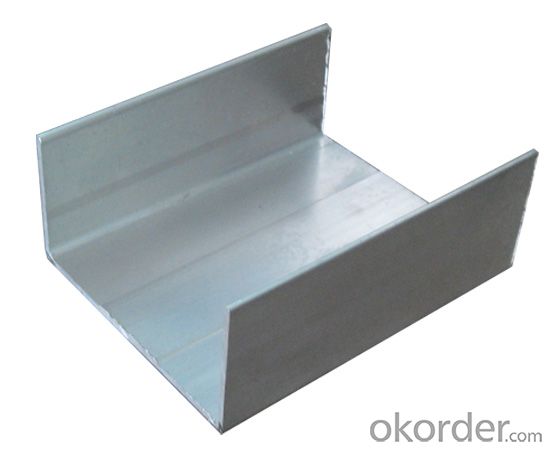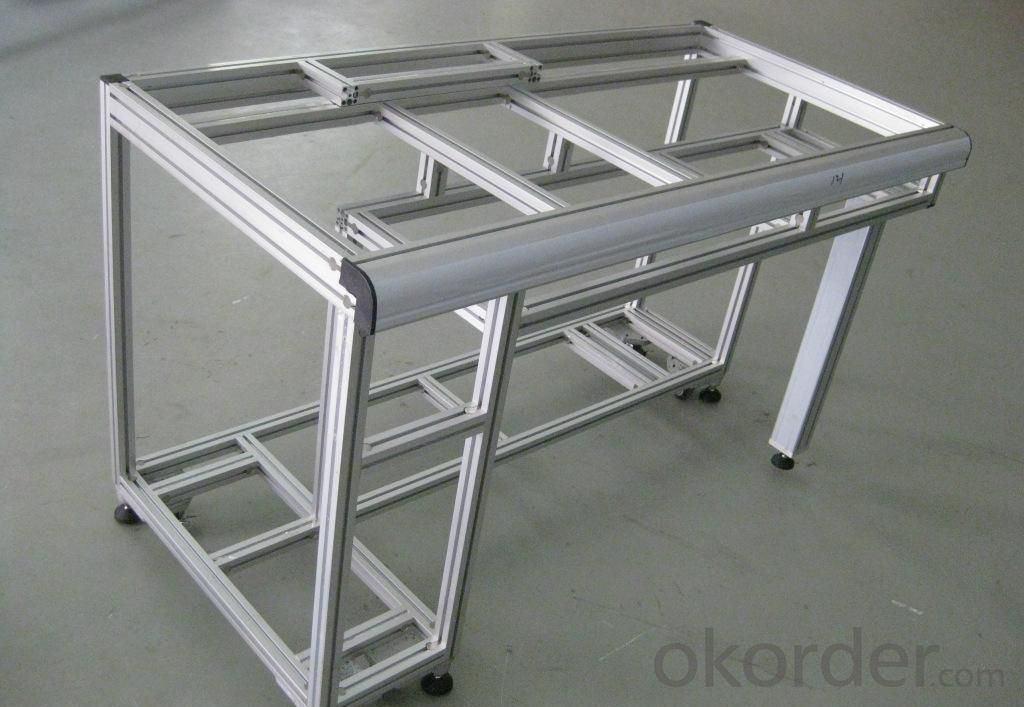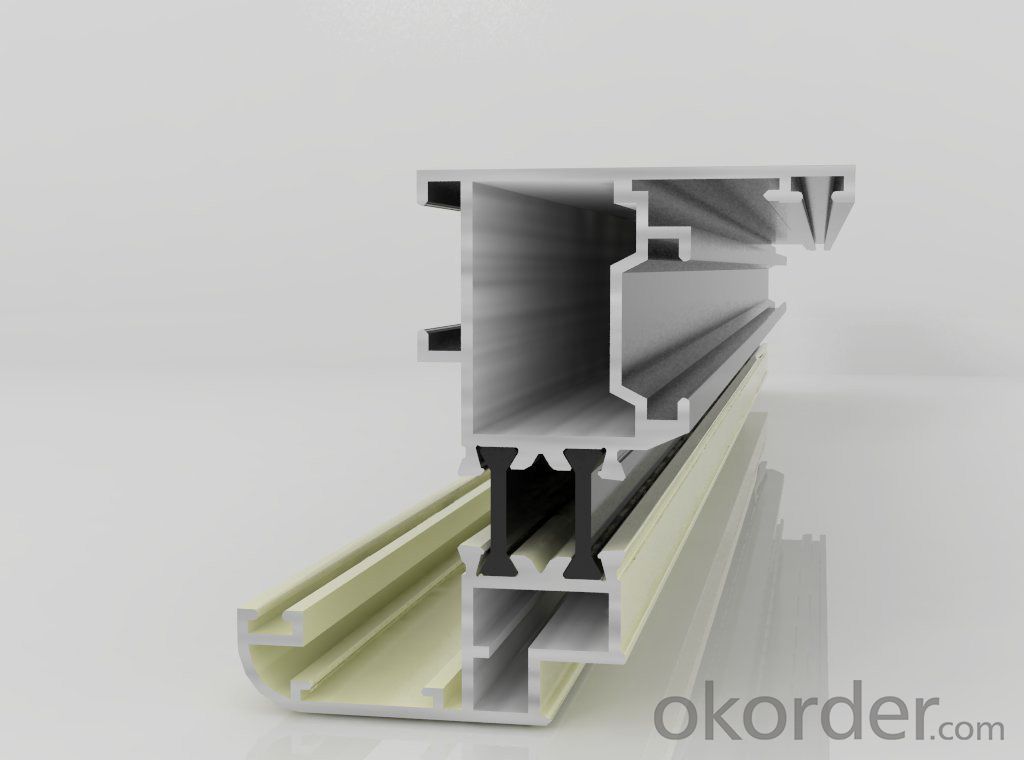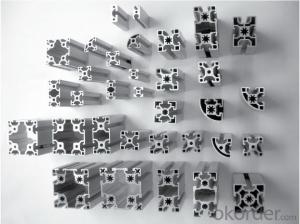Aluminum Profile Sliding Windows Top Quality
- Loading Port:
- Shanghai
- Payment Terms:
- TT OR LC
- Min Order Qty:
- 5 m.t.
- Supply Capability:
- 5000 m.t./month
OKorder Service Pledge
OKorder Financial Service
You Might Also Like
Item specifice
Structure of Aluminum Profile Sliding Windows Top Quality Description:
We have more than 10 years experiences on manufacturing kinds of aluminum profiles, such as Aluminum Window & Door profiles, Aluminum tile trim profiles, Aluminum profiles for LED light, Round/Square General profiles, Aluminum heat sink, Aluminum heating insulation profiles, Curtain wall Aluminum profiles, and others Industry profiles.
Our products have exported to all over the world, and we also have a large of market share in Algeria, Angola, Philippine, Guinea, Ghana, South Africa, Nepal, Nigeria, Tanzania, Iraq etc.
Main Features of the Aluminum Profile Sliding Windows Top Quality:
1, Strong R&G: help customers finalize the design, strong tool design ability, excellent, pressing and surface treatment technology;
2, Strong quality management: ISO&SGS SYSTEM;
3, 24 hours on-line communication, professional, patient, flexible;
4, High capacity of manufacturing and wide range of products;
5, We can provide secondary manufacturing.
6, High corrosion resistance, high weather resistance and good wear resistance.
7, Alternative surface treatment: Colorful ANODIZE, POWDER COATING, ELECTROPHORESIS & WOODEN GRAIN. Plentiful colors upon your needs.
8, Excellent material for smooth and subtle edges, elegant appearance.
9, Strong coated adhesion which is suitable for construction and industrial material.
Images of the Aluminum Profile Sliding Windows Top Quality:



Aluminum Profile Sliding Windows Top Quality Specification:
Material | Alloy Aluminum 6063,6061,6005 or customer nominated |
Temper | T3, T4, T5, T6 |
Surface | Anodize, electrophoresis, powder coating, PVDF coating, wood grain painting, matted, etc. |
Colour | Any colour based on Standard Germany RAL Mark |
Length | Coating 6.5 meters, Anodizing 6.5 meters, Mill finish 5 meters |
Press Machine | 500-4000 tons all together 64 press lines. |
Fabrication | 1. Windows and doors; 2. Drilling; 3. Bending; 4. Cutting; 5. etc. |
Certificate | ISO 9001 |
Moulding | 1. Using our moulds, no fee; |
2. Using customer drawing, opening mould, usually about 10~50 tons then the moulding can be refunded. | |
3. Mould cost is negotiable base on the order quantity | |
Capability | Annual output 100,000 tons |
FAQ:
1.Q: What about leadtime ?
A: Normally the leadtime is 60days after we receive the deposit and confirm the details. All the press machines we use is the best quality in China Yangli brand. The press machine leadtime from Yangli is 50days, the best leadtime we can give is 60days.
2.Q: What's the lead time for moulds?
A: Normally the mould leadtime is 45 days after we confirm all the details with customer. Our professional mechanical enginners from Austria will design the mould according to the samples from customer, or by the specifications offered by customers.
3.Q:What kinds of mould you can make? and what is your strong point for the moulds?
A: we can make wrinkle wall mould and smooth wall mould both. For wrinkle wall mould we can make, 79" pan, fish pan, bbq pan. For smooth wall mould we can make muffin cup, and cake cup, tar cup,etc. We can also make 2 or 3 portion conatiner moulds as long as you offer us sample or specifications. Our strong points are all our moulds are WEDMLS cut, which makes the mould more accurate and precise. Important materials likestainless steel parts we make in Austria. We also recut after heat treatment, which most of makers do not take this process.
- Q:How do aluminum profiles contribute to sustainable building practices?
- Aluminum profiles play a crucial role in promoting sustainable building practices for several reasons. Firstly, aluminum is a highly recyclable material, meaning that it can be melted down and reused multiple times without any loss in quality. This recyclability greatly reduces the need for extracting and processing virgin aluminum, which is an energy-intensive and environmentally damaging process. By using aluminum profiles in construction, we can significantly minimize the demand for new aluminum production, thus conserving natural resources and reducing carbon emissions. Moreover, aluminum profiles are lightweight yet strong, making them ideal for creating energy-efficient structures. The lightweight nature of aluminum reduces the load on the building's foundation and structural elements, resulting in lower material requirements and reduced construction costs. Additionally, a lighter structure requires less energy to heat and cool, leading to decreased energy consumption and reduced greenhouse gas emissions over the building's lifespan. Furthermore, aluminum profiles have excellent thermal and acoustic insulation properties. When properly utilized, they can contribute to the overall energy efficiency of a building by minimizing heat loss or gain through windows and doors. This translates into reduced reliance on artificial heating and cooling systems, leading to decreased energy consumption and lower utility bills. Additionally, aluminum profiles are highly durable and require minimal maintenance. Their resistance to corrosion, weathering, and UV rays ensures a long lifespan, reducing the need for frequent replacements and repairs. This not only saves resources but also reduces waste generation and landfill usage. Lastly, aluminum profiles offer great design flexibility and can be easily integrated into various architectural styles and designs. This versatility enables architects and builders to create aesthetically pleasing and functional structures that meet the needs of occupants while still adhering to sustainable building practices. In conclusion, aluminum profiles contribute to sustainable building practices by being recyclable, lightweight, energy-efficient, thermally insulating, durable, low maintenance, and versatile. By incorporating aluminum profiles into construction projects, we can reduce our environmental footprint, conserve natural resources, and promote a more sustainable future.
- Q:Are aluminum profiles suitable for use in furniture fittings and accessories?
- Yes, aluminum profiles are indeed suitable for use in furniture fittings and accessories. Aluminum is a versatile material that offers several advantages for furniture applications. Firstly, aluminum profiles are lightweight, making them easy to handle and install. This is particularly beneficial for furniture fittings and accessories that may require frequent adjustments or movements. Additionally, aluminum profiles are highly durable and resistant to corrosion, ensuring a long lifespan for furniture fittings and accessories. This makes them suitable for both indoor and outdoor furniture, as they can withstand various environmental conditions without deteriorating. Aluminum is also highly customizable, allowing for a wide range of design options. It can be easily shaped, cut, and welded into various forms and sizes, enabling furniture designers to create unique and aesthetically pleasing fittings and accessories. Moreover, aluminum profiles are low-maintenance and easy to clean, making them ideal for furniture applications. They can be easily wiped down or washed without the risk of damage or degradation. Furthermore, aluminum is a sustainable and environmentally friendly material. It is 100% recyclable, meaning that it can be reused indefinitely without losing its properties. Using aluminum profiles in furniture fittings and accessories contributes to a more sustainable and eco-friendly design approach. Overall, the combination of lightweight, durability, customization options, low-maintenance, and sustainability makes aluminum profiles a suitable choice for use in furniture fittings and accessories. They offer numerous benefits and can enhance the functionality, aesthetics, and longevity of furniture pieces.
- Q:What are the different surface texturing options for aluminum profiles?
- There are several surface texturing options available for aluminum profiles, each offering unique benefits and aesthetic appeal. Some of the common surface texturing options for aluminum profiles include: 1. Brushing or Satin Finishing: This technique involves the use of abrasive brushes to create a linear or circular pattern on the surface of the aluminum profile. It provides a smooth, matte finish, which is visually appealing and hides minor imperfections. 2. Anodizing: Anodizing is a popular surface treatment method that involves creating an oxide layer on the aluminum surface. This process not only enhances the corrosion resistance of the profile but also allows for the application of various colors, making it an excellent choice for decorative applications. 3. Polishing: Polishing is a process that involves mechanically smoothing the surface of the aluminum profile to achieve a reflective finish. This technique is commonly used in architectural applications where a high-gloss appearance is desired. 4. Powder Coating: Powder coating is a durable and versatile surface treatment option for aluminum profiles. A dry powder is electrostatically applied to the profile, and then it is cured under heat, creating a protective and decorative coating. Powder coating provides a wide range of color options and excellent resistance to weathering, making it suitable for both interior and exterior applications. 5. Textured Coating: Textured coating is a specialized powder coating technique that offers a unique texture and appearance to the aluminum profile. It can mimic various textures, such as wood grain or stone, adding a distinctive look to the profile. 6. Chemical Etching: Chemical etching is a process that involves selectively removing material from the surface of the aluminum profile using chemical solutions. This technique can create intricate patterns or designs on the surface, making it ideal for decorative or branding purposes. 7. Laser Engraving: Laser engraving is a precise and versatile method for creating patterns, logos, or text on the surface of aluminum profiles. The laser beam removes the material, leaving a permanent mark on the profile. Laser engraving offers high precision and customization options, making it suitable for branding and personalization. These are just a few examples of the surface texturing options available for aluminum profiles. The choice of texturing method depends on the desired appearance, functionality, and application of the profile.
- Q:What are the different surface patterns available for aluminum profiles?
- There are several different surface patterns available for aluminum profiles, each offering unique aesthetic and functional benefits. Some of the most commonly used surface patterns include: 1. Smooth: This is the most basic surface pattern, with a smooth and polished finish. It provides a sleek and modern appearance, making it ideal for applications where aesthetics are important. 2. Brushed: This surface pattern is characterized by fine lines or brush strokes running in a single direction. It creates a textured and satin-like appearance, which is often chosen for its contemporary and industrial appeal. 3. Anodized: Anodizing is an electrochemical process that creates a durable and corrosion-resistant surface on aluminum profiles. It can be customized to produce various colors and finishes, such as matte, glossy, or metallic. 4. Powder-coated: Powder coating involves applying a dry powder onto the aluminum surface and then heating it to create a smooth and durable finish. This process allows for a wide range of colors and textures, including matte, glossy, and textured finishes. 5. Wood grain: By using a specialized printing process, aluminum profiles can be made to mimic the appearance of wood. This surface pattern offers the natural and warm look of wood, while providing the benefits of aluminum, such as durability and low maintenance. 6. Textured: Aluminum profiles can also be given a textured surface pattern, which can range from a fine sand-like texture to a more pronounced embossed or hammered look. Textured surfaces not only enhance the visual appeal but also provide better grip and slip resistance. These are just a few examples of the many surface patterns available for aluminum profiles. The choice of surface pattern depends on the specific application requirements, desired aesthetics, and functional needs.
- Q:What are the different surface finishing options available for aluminum profiles?
- There are several surface finishing options available for aluminum profiles, each offering different benefits and aesthetic appearances. Some of the commonly used surface finishing options for aluminum profiles include: 1. Anodizing: Anodizing is an electrochemical process that creates a protective oxide layer on the surface of the aluminum. This process not only enhances corrosion resistance but also provides a variety of color options. Anodized aluminum profiles are durable, easy to maintain, and have a smooth, attractive finish. 2. Powder Coating: Powder coating involves applying a dry powder to the surface of the aluminum profile and then curing it under heat. This process creates a tough, decorative finish that is resistant to chipping, scratching, and fading. Powder coating offers a wide range of color options and can be customized to achieve different textures and effects. 3. Polishing: Polishing is a mechanical process that creates a high-gloss, reflective finish on the aluminum profile. It involves using abrasives and polishing compounds to remove surface imperfections and achieve a smooth, mirror-like appearance. Polished aluminum profiles are commonly used in decorative applications where a sleek and shiny finish is desired. 4. Brushing: Brushing involves using abrasive brushes or pads to create a textured, brushed finish on the aluminum profile. This process produces parallel lines or circular patterns on the surface, giving it a unique and stylish appearance. Brushed aluminum profiles are often used in architectural and interior design applications. 5. Electrophoretic Coating: Electrophoretic coating, also known as e-coating, is an immersion process where an electrically charged paint is applied to the aluminum profile. This process ensures uniform coating thickness and excellent corrosion resistance. E-coating provides a smooth, even finish and is commonly used in automotive and industrial applications. 6. Wood Grain Effect: Aluminum profiles can be treated with a special coating to mimic the appearance of wood grain. This option is popular in architectural applications where the durability and low maintenance of aluminum are preferred over natural wood. These are just a few of the surface finishing options available for aluminum profiles. The choice of finishing method depends on the desired appearance, functionality, and intended application of the aluminum profile.
- Q:Can aluminum profiles be used in the production of automotive interiors?
- Indeed, the utilization of aluminum profiles is viable for the production of automotive interiors. Aluminum, being a lightweight and resilient material, offers a plethora of advantages in the realm of automotive applications. Its exceptional resistance to corrosion is particularly significant, as it enables endurance in the demanding conditions within vehicles. Aluminum profiles possess the capability to fashion various components found in automotive interiors, including but not limited to door panels, instrument panels, seat frames, and trim pieces. Moreover, the malleability and adaptability of aluminum profiles facilitate the fulfillment of specific design requirements, thereby granting flexibility in the realm of automotive interior design. The incorporation of aluminum profiles in automotive interiors contributes to a reduction in overall vehicle weight, thereby enhancing fuel efficiency and diminishing emissions.
- Q:Are aluminum profiles suitable for use in the defense industry?
- The defense industry finds aluminum profiles to be a fitting option. Aluminum, a lightweight material, possesses an excellent strength-to-weight ratio, making it the preferred choice for various defense applications. Military vehicles, aircraft, and naval vessels can be constructed using aluminum profiles, which significantly contribute to weight reduction, thus enhancing performance and fuel efficiency. Moreover, aluminum profiles exhibit remarkable resistance to corrosion, a crucial characteristic for defense equipment exposed to harsh conditions like saltwater or extreme weather. They also display efficient thermal conductivity, enabling effective heat dissipation in electronic components and systems. In addition to these advantages, aluminum profiles offer exceptional design versatility and can be easily machined, welded, and formed into intricate shapes. This adaptability allows for customization, meeting specific defense requirements. Furthermore, aluminum profiles contribute to cost-effectiveness as they are readily available, recyclable, and offer long-term durability. To conclude, due to their lightweight nature, resistance to corrosion, thermal conductivity, versatility, and cost-effectiveness, aluminum profiles prove to be a suitable choice for the defense industry. These properties make them ideal for a wide range of applications, ensuring the durability and performance of defense equipment.
- Q:Can aluminum profiles be used in construction?
- Yes, aluminum profiles can be used in construction. Aluminum is a lightweight, durable, and corrosion-resistant material, making it suitable for various construction applications. It is often used in the construction of windows, doors, curtain walls, and roofing systems. Aluminum profiles offer flexibility in design, allowing for the creation of complex shapes and structures. Additionally, aluminum is a sustainable material as it is highly recyclable, making it an environmentally friendly choice for construction projects.
- Q:What are the advantages of using aluminum profiles in the oil and gas industry?
- There are several advantages of using aluminum profiles in the oil and gas industry. Firstly, aluminum profiles are lightweight yet highly durable, making them ideal for applications that require strength and resistance to harsh environments. Secondly, aluminum profiles have excellent corrosion resistance properties, ensuring their longevity even in corrosive environments found in the oil and gas industry. Additionally, aluminum profiles offer excellent thermal conductivity, allowing for efficient heat transfer and management in various oil and gas processes. Furthermore, aluminum profiles are easy to fabricate and assemble, enabling quick and cost-effective installation. Lastly, aluminum is a recyclable material, aligning with sustainability goals and reducing environmental impact in the oil and gas industry.
- Q:Can aluminum profiles be used in noise insulation applications?
- Indeed, noise insulation applications can indeed make use of aluminum profiles. These profiles possess remarkable versatility and can be specifically engineered to exhibit exceptional acoustic properties. Consequently, they can serve as the foundation for constructing soundproof windows, doors, walls, and enclosures. By combining aluminum profiles with materials such as acoustic glass, rubber seals, and insulation foam, their noise insulation capabilities can be further enhanced. Moreover, owing to aluminum's inherent strength and durability, it is perfectly suited for deployment in noise insulation applications, as it can withstand the pressures and vibrations generated by sound waves. In summary, aluminum profiles represent a feasible solution for fulfilling noise insulation requirements across various settings, including residential, commercial, and industrial buildings.
1. Manufacturer Overview |
|
|---|---|
| Location | |
| Year Established | |
| Annual Output Value | |
| Main Markets | |
| Company Certifications | |
2. Manufacturer Certificates |
|
|---|---|
| a) Certification Name | |
| Range | |
| Reference | |
| Validity Period | |
3. Manufacturer Capability |
|
|---|---|
| a)Trade Capacity | |
| Nearest Port | |
| Export Percentage | |
| No.of Employees in Trade Department | |
| Language Spoken: | |
| b)Factory Information | |
| Factory Size: | |
| No. of Production Lines | |
| Contract Manufacturing | |
| Product Price Range | |
Send your message to us
Aluminum Profile Sliding Windows Top Quality
- Loading Port:
- Shanghai
- Payment Terms:
- TT OR LC
- Min Order Qty:
- 5 m.t.
- Supply Capability:
- 5000 m.t./month
OKorder Service Pledge
OKorder Financial Service
Similar products
New products
Hot products
Related keywords































